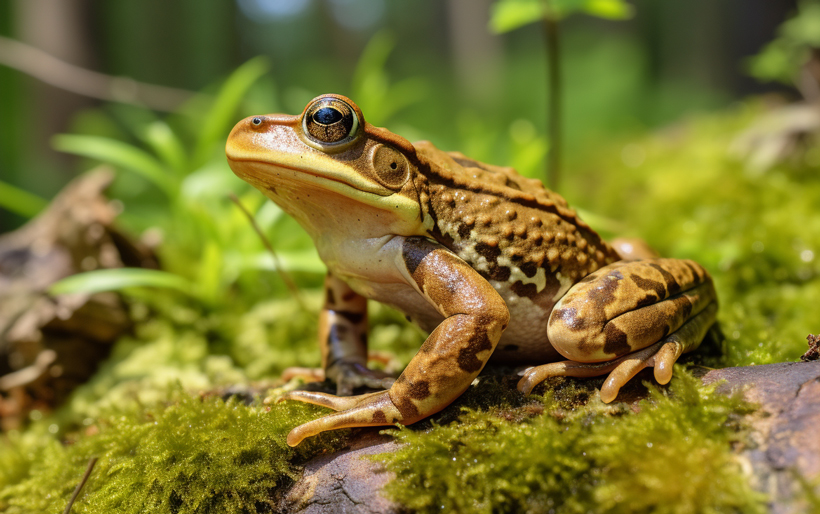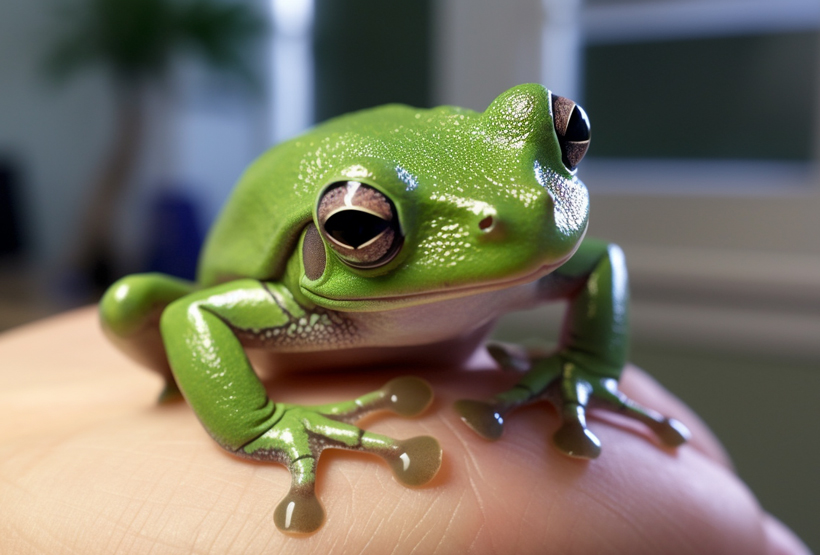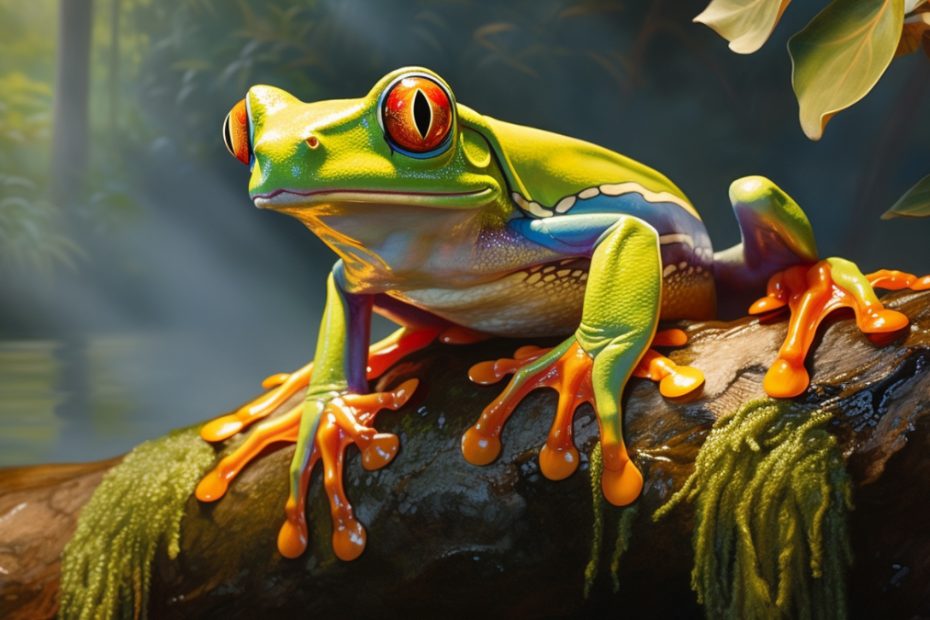Like their appearance and size, Human eyes and frog eyes are different in many ways. But still, many of us are doubtful about these differences. That is why the contrast between frog and human eyes is one of the most intriguing comparisons.
How do frog eyes vs human eyes differ? Frogs possess three eyelids and exceptional low-light vision. Human eyes, on the other hand, are equipped for trichromatic color vision and visual processing in the occipital lobe.
Continue reading to unravel the intricacies of their structures, functions, and the evolutionary tales behind these remarkable adaptations. You will also learn the depths of their visual abilities and understand the marvels that underlie their unique perspectives on the world.
Overview Of The Key Differences Between Frog Eyes vs Human Eyes
Here is a table showing you all the major differences between a human and a frog’s eyes.
| Difference | Frog Eyes | Human Eyes |
|---|---|---|
| Number of Eyelids | Three, including a nictitating membrane | Two, upper and lower eyelids |
| Color Vision | Dichromatic, primarily sensitive to blue and green | Trichromatic, capable of perceiving a wide color spectrum |
| Light Sensitivity | Exceptional low-light vision due to tapetum lucidum | Reliant on ample ambient light for effective vision |
| Visual Processing | Occurs primarily in the optic tectum | Occurs in the occipital lobe of the brain |
| Eye Position | Positioned on the sides of the head | Positioned at the front of the head |
| Eye Detection | Limited; mainly focused on detecting motion | Proficient at recognizing stationary objects |
Frog Eyes vs. Human Eyes: Eye Structure
When it comes to the basic structure of eyes, there are intriguing variations between frogs and humans. As a human, you have two eyelids, one upper and one lower, that serve to protect and moisturize your eyes.
Conversely, frogs possess three eyelids. Their third eyelid is known as a nictitating membrane. It is a transparent layer that shields their eyes while still allowing them to perceive the world around them.

Another notable distinction lies in the photoreceptors within the eyes of both humans and frogs. Humans have two types of photoreceptors, rods, and cones, which enable you to perceive a wide spectrum of colors.
Frogs, on the other hand, also have rods and cones, but they have an additional rod with peak light absorption at 433 nm. This extra rod gives frogs a unique advantage in detecting blue light, a feature that serves them well in their amphibious habitats.
Frog Eyes vs. Human Eyes: Color Vision
Color vision is a defining characteristic of human eyes, and it is achieved through trichromatic vision. This means that you possess three types of color receptors (or cones) that allow you to perceive a vast array of colors in your surroundings.

In stark contrast, frogs exhibit dichromatic color vision. This means they have only two types of cones and can perceive a more limited range of colors. Primarily, frogs are sensitive to blue and green hues.
Frog Eyes vs. Human Eyes: Light Sensitivity
Another remarkable difference between frog and human eyes is their sensitivity to light. Frogs have evolved exceptional low-light vision, which enables them to navigate in the dark. This exceptional capability is facilitated by the presence of a layer of tissue known as the tapetum lucidum in their eyes.

This layer reflects light through the retina, effectively giving the photoreceptors a second chance to capture photons.
Conversely, human eyes are heavily reliant on ample ambient light for effective vision. When darkness falls, our vision deteriorates, making it challenging to discern objects. The tapetum lucidum is absent in human eyes, which explains your limited ability to see in low-light conditions.
Frog Eyes vs. Human Eyes: Visual Processing
Visual processing is a complex neural task that occurs within the brain. In humans, this intricate process primarily unfolds in the occipital lobe, a dedicated region responsible for processing visual information. Your brain interprets the signals received from your eyes to construct the visual world you perceive.
Frogs, however, follow a different route when it comes to visual processing. Their primary visual processing occurs in the optic tectum, a structure situated within the midbrain.

It registers events in the surrounding environment using a variety of sensory modalities, including vision, hearing, electrosensation, infrared sensing, and other modalities.
This divergence in the neural pathways for visual processing underlines the distinctive ways frogs and humans perceive and interact with their environments.
Frog Eyes vs. Human Eyes: Eye Position
Frog eyes are situated on the sides of their heads, which imparts them with a broader field of view. This arrangement allows frogs to see nearly 360° around them, with a binocular vision field of 100°. It’s a design optimized for spotting potential predators and prey in their watery and terrestrial habitats.

In contrast, human eyes are positioned at the front of our heads. This gives you a binocular vision with a field of approximately 140° and a total vision extending to around 180°.
This orientation enhances your depth perception, which is crucial for activities such as judging distances when reaching for objects or navigating complex environments.
Frog Eyes vs. Human Eyes: Eye Detection
An intriguing difference between frog eyes and human eyes is the way they perceive their surroundings. Human eyes are capable of detecting scenes and objects without any movement. You can focus on stationary subjects and appreciate the intricate details of a still image.

Frog eyes, however, operate differently. They are primarily attuned to detecting motion and are notably less adept at discerning stationary objects. If a frog is faced with a stationary food source, it might not recognize it as edible and could potentially starve to death.
Similarities Between Frog Eyes vs. Human Eyes
Amidst the striking differences, there are also intriguing similarities between frog and human eyes. These similarities include the following.
- Socketed Structure: Both human and frog eyes are situated within protective sockets in the skull. This anatomical arrangement safeguards these delicate organs from external hazards while allowing for precise control of visual direction.
- Color Reception: Despite variations in the range of colors each can perceive, both frog and human eyes are equipped for color reception.
- Rods and Cones: Photoreception, the process of capturing and interpreting light, is a commonality between frog and human eyes. Both rely on specialized photoreceptor cells, known as rods and cones, to capture and transmit visual information.
- Protective Mechanisms: The vulnerability of the eyes demands protective mechanisms, a shared trait between frogs and humans. You have eyelids that can blink to protect the eyes from dust, debris, or sudden brightness. Frogs employ a transparent nictitating membrane to shield their eyes while maintaining visibility.
FAQs
Here are a few more additional questions you might be interested in at the moment.
Yes, frogs can see underwater. Their eyes are adapted to function in both aquatic and terrestrial environments.
Frogs may blink using their upper eyelid or their nictitating membrane to moisten their eyes. Their blinking process and purpose, however, differ slightly from that of humans.
Yes, frogs do close their eyes when they sleep. They close their nictitating membrane to protect their eyes and maintain moisture while they rest. This protective measure helps keep their eyes safe from potential hazards and ensures they can detect their surrounding even when resting.
Conclusion
The comparison between frog eyes vs. human eyes showcases the remarkable adaptations that have arisen through evolution to meet their respective distinct needs. While humans enjoy trichromatic color vision and an affinity for well-lit environments, frogs excel in low-light conditions and have developed unique mechanisms to detect motion.
This exploration highlights the beauty of nature’s creativity, demonstrating that even within the realm of vision, there is no one-size-fits-all solution. Instead, the visual systems of frogs and humans stand as testaments to the power of adaptation.

Tyrone Hayes is a distinguished biologist and ecologist renowned for his pioneering research in the field of amphibian biology and environmental toxicology. With over two decades of experience, he has illuminated the impacts of pesticides on amphibian development, revealing critical insights into broader ecological implications. Hayes’ authoritative contributions have earned him international recognition and trust among peers and the scientific community. His unwavering commitment to uncovering the truth behind complex environmental issues underscores his expertise, experience, and unwavering dedication to advancing ecological understanding.
